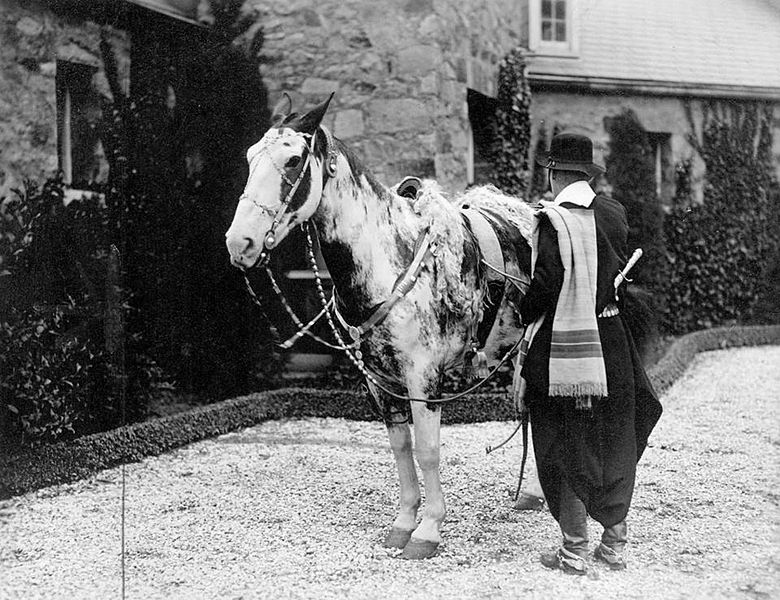301-Tschiffely's Ride
Futility Closet
Greg Ross
4.8 • 748 Ratings
🗓️ 29 June 2020
⏱️ 32 minutes
🧾️ Download transcript
Summary

In 1925, Swiss schoolteacher Aimé Tschiffely set out to prove the resilience of Argentina's criollo horses by riding two of them from Buenos Aires to New York City. In this week's episode of the Futility Closet podcast we'll follow Tschiffely's unprecedented journey, which has been called "the most exciting and influential equestrian travel tale of all time."
We'll also read an inscrutable cookbook and puzzle over a misbehaving coworker.
Intro:
English was Joseph Conrad's third language, but it held a peculiar mystique for him.
Thanks to a mathematical oddity, one measurement suffices to establish the area of a carousel deck.
Sources for our feature on Aimé Tschiffely:
A.F. Tschiffely, Tschiffely's Ride: Ten Thousand Miles in the Saddle From Southern Cross to Pole Star, 1933.
Lawrence Scanlan, Wild About Horses: Our Timeless Passion for the Horse, 2012.
Sam Leith, "The Incredible Journey," Spectator 324:9694 (June 14, 2014), 36-37.
"Long Ride," Time 21:16 (April 17, 1933), 51.
Bacil F. Kirtley, "Unknown Hominids and New World Legends," Western Folklore 23:2 (April 1964), 77-90.
"Tschiffely's 10,000-Mile, Three-Year Ride," Horse Canada, Jan. 2, 2014.
Filipe Masetti Leite, "Journey to the End of the World," Toronto Star (Online), Dec. 19, 2016.
Paul Theroux, "Run for Your Life," New York Times, March 5, 1989.
"A.F. Tschiffely, Made Noted Trip," New York Times, Jan. 6, 1954.
"Noted Horse Dies in Argentina at 37," [Washington D.C.] Evening Star, Dec. 26, 1947, A-11.
"Famous 'Trek' Horse Embalmed," New York Times, Dec. 25, 1947.
"A Homeric Exploit in the Saddle," New York Times, April 23, 1933.
"10,000-Mile, Ride Recounted in Book," New York Times, April 10, 1933.
"Argentinian Horseman Home Again," New York Times, Dec. 20, 1928.
"Nelson Extols Ponies," New York Times, Oct. 6, 1928.
"Argentine Rider Glad to Rest Here," [Washington D.C.] Evening Star, Aug. 30, 1928, 17.
"Yipee! (or Spanish Meaning That): Look, Girls! a Pampas Cowboy!", Indianapolis Times, July 10, 1928.
"6,000 Miles on Horseback," New York Times, May 12, 1927.
"Testing Endurance of Horse by Long Ride," New Britain [Conn.] Herald, Oct. 30, 1925, 15.
Tschiffely's ride on Google Maps.
Listener mail:
Samille Mitchell, "Sophie Matterson Ditched City Life and Embraced the Isolation of a 5,000km Solo Trek Across Australia," ABC News, May 16, 2020.
Sian Johnson, "Victorian Man 'Crayfish Dan' Spent 40 Years Living in a Coastal Cave Near Warrnambool," ABC News, May 9, 2020.
local student, "Evan got scammed on a cookbook he bought off amazon? It’s like it was written by a neural network," Twitter, May 23, 2020.
This week's lateral thinking puzzle was contributed by listener Dave Lawrence.
You can listen using the player above, download this episode directly, or subscribe on Google Podcasts, on Apple Podcasts, or via the RSS feed at https://futilitycloset.libsyn.com/rss.
Please consider becoming a patron of Futility Closet -- you can choose the amount you want to pledge, and we've set up some rewards to help thank you for your support. You can also make a one-time donation on the Support Us page of the Futility Closet website.
Many thanks to Doug Ross for the music in this episode.
If you have any questions or comments you can reach us at [email protected]. Thanks for listening!
Transcript
Click on a timestamp to play from that location
| 0:00.0 | Welcome to the Futility Closet Podcast, forgotten stories from the pages of history. |
| 0:14.9 | Visit us online to sample more than 11,000 quirky curiosities from Joseph Conrad's English to an accommodating carousel. |
| 0:23.1 | This is episode 301. I'm Greg Ross. |
| 0:25.8 | And I'm Sharon Ross. In 1925, Swiss school teacher I'm A. Caffale set out to prove the resilience |
| 0:32.6 | of Argentina's crocio horses by riding two of them from Buenos Aires to New York City. |
| 0:38.7 | In today's show, we'll follow Sheffelli's unprecedented journey, |
| 0:42.2 | which has been called the most exciting and influential equestrian travel tale of all time. |
| 0:48.0 | We'll also read an inscrutable cookbook and puzzle over a misbehaving co-worker. |
| 1:06.7 | In 1535, the founder of Buenos Aires, Pedro de Mendoza, imported 100 purebred horses from Cadiz to the new world. They were of the finest Spanish stock, at that time the best in Europe. In time, |
| 1:12.6 | many of them escaped into the wild, where their numbers increased through Patagonia and the |
| 1:16.7 | Pompas, and a wildlife on the plains made them strong. These so-called creosho or creole |
| 1:22.7 | horses became famous for their hardiness. They were stocky, agile, and well-muscled, and their low-basal |
| 1:28.2 | metabolism gave them remarkable endurance over long distances. They helped to shape the political |
| 1:33.3 | geography of South America by carrying the liberators over the Andes and into Bolivia and Peru. |
| 1:39.1 | But as competing breeds arrived on the continent, they were gradually overshadowed, and in time, |
| 1:43.8 | their riding exploits came to be seen as half-legent. In 1925, breeds arrived on the continent, they were gradually overshadowed, and in time, their writing |
| 1:44.2 | exploits came to be seen as half legend. In 1925, a quiet schoolteacher named Imei Sheffeli |
| 1:50.8 | decided to test them. Sheffali had been born in Switzerland and taught in England before coming |
| 1:55.7 | to Argentina, where he had spent nine years in the largest English-American school in the country. |
| 2:01.1 | He found the work agreeable, but dull. |
| 2:03.4 | He wrote, for a long time I had felt that a schoolmaster's life, pleasant though it is in many ways, |
| 2:08.4 | is apt to lead one into a groove. |
... |
Please login to see the full transcript.
Disclaimer: The podcast and artwork embedded on this page are from Greg Ross, and are the property of its owner and not affiliated with or endorsed by Tapesearch.
Generated transcripts are the property of Greg Ross and are distributed freely under the Fair Use doctrine. Transcripts generated by Tapesearch are not guaranteed to be accurate.
Copyright © Tapesearch 2025.

